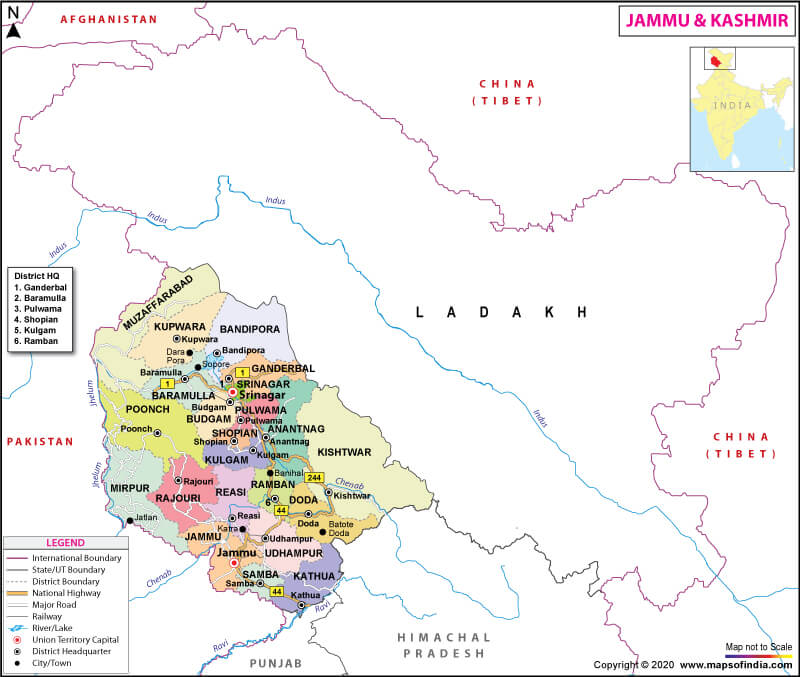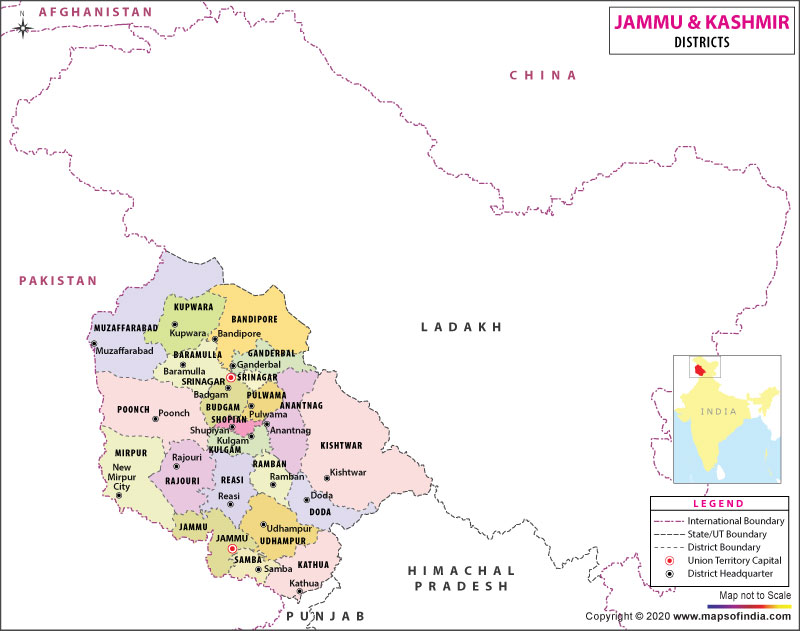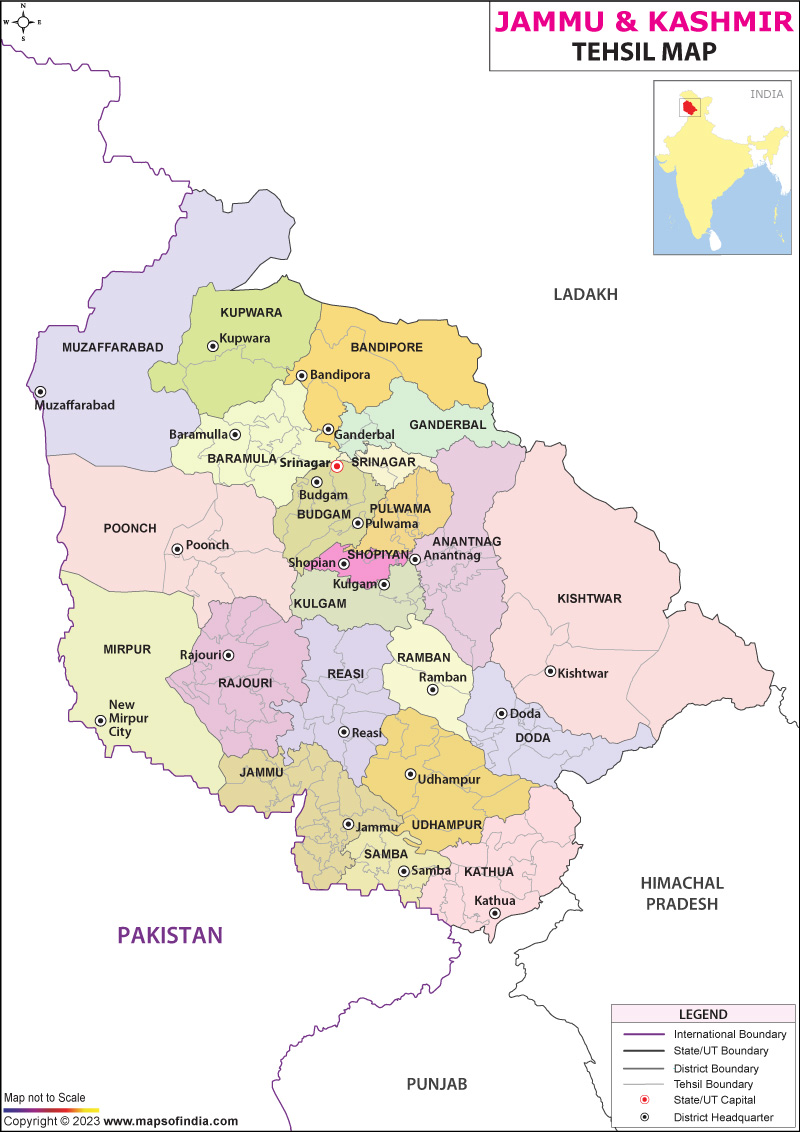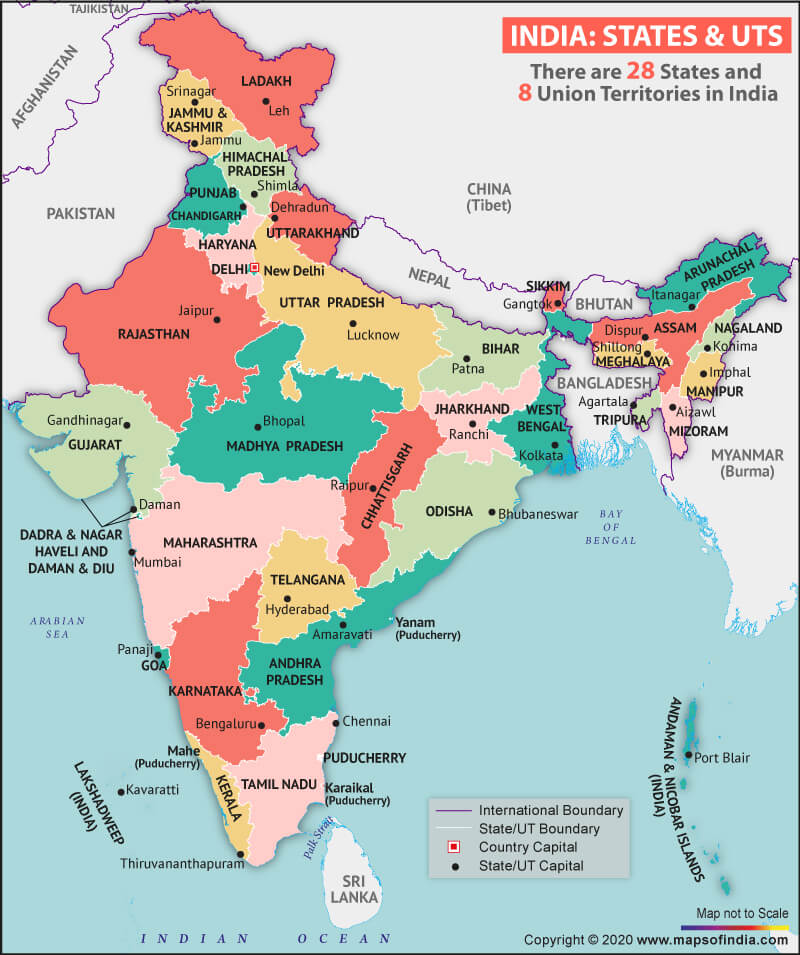

Where is Jammu and Kashmir?
Jammu and Kashmir, the Union Territory (UT) of India, is in northern India. It is located to the north of Himachal Pradesh and Punjab, and west of Ladakh. The formation of Jammu and Kashmir as a Union Territory took place on October 31, 2019. Jammu and Kashmir has two capitals, Srinagar, the summer capital, (May–October) and Jammu, winter capital (Nov-April).
What is the Geography of Jammu and Kashmir?
Jammu and Kashmir spreads across a total area of 42,241 sq. km (16,309 sq. mi). Its population recorded 9,944,283 (as per the 2011 census). The population density of the UT was 240/sq. km (610/sq. mi) (as per the 2011 census).
The highest elevation point of Jammu and Kashmir is Nun Peak, which is 7,135 m (23,409 ft), while its lowest elevation point is the Chenab River, which is 247 m (810 ft).
The Union Territory has many rivers and lakes. Some significant rivers that flow through Jammu and Kashmir are- Jhelum, Chenab, Tawi, and Ravi. Jammu and Kashmir is blessed with lakes as well like Manasbal Lake, Wular Lake, and Dal Lake.
It has several incredible mountain peaks like Amarnath Peak, Brammah, Harmukh, and Kazinag Peak. Nun Peak is the highest mountain peak in the Union Territory.
The Union Territory is known for dams as well such as Baglihar Dam, Kishanganga Hydroelectric Power Station, Pakal Dul Dam, and Ratle Hydroelectric Plant.
What is the Climate of Jammu and Kashmir?
Mountains surround Jammu and Kashmir, which also influence its climate. The climate of Kashmir is somewhat moderate, while Jammu has a sub-tropical climate, here summer is warm.
The average summer temperature in Jammu remains in the range of 77°F (25°c) to 100°F (38°c). But the winter temperature in Jammu region remains between 41°F ( 5°C) 63°F (17°C).
Kashmir is quite pleasant. It experiences summer temperature around 57°F (14°C) to 86°F (30°C). But temperature dips drastically in winter which remains in the range of 21°F ( -6°C) to 50°F (10°C).
The annual rainfall in Kashmir is about 693 mm (27.3 inches), while Jammu experiences average yearly rainfall around 1238 mm (48.7 inches).
Srinagar, Gulmarg and Pahalgam and some other places experience snowfall in winter. Adventure sports take place during snowfall as well. Tourists visit in large numbers to see the breathtaking scenery of snowfall.
January and June are the coldest and hottest months, respectively, in the Jammu region, while in Kashmir, January and July are the coldest and hottest months of the year.
What is the Economy of Jammu and Kashmir?
The climate of Jammu and Kashmir is suitable for horticulture and floriculture. Horticulture is the backbone of the rural economy of the UT. It employs a large number of people. Apple production in the Union Territory is immense. Apple of Jammu and Kashmir is famous across the country.
Agriculture is the lifeline of the people of Jammu and Kashmir. The Union Territory produces several crops such as- rice, corn, millet, pulses, wheat, and so on. It also produces ‘Saffron’, which is rarely grown in the Indian sub-continent. Walnuts, almonds, peaches, and cherries are also grown in Jammu and Kashmir.
The Union Territory is known for power generation. As of February 2020, it had a total installed power generation capacity of 3,417.13 MW, which is divided as – 1,812.35 MW under central utilities, 1,535.48 MW under Union Territory utilities and 69.30 MW under private services.
The principal industries of the Union Territory are horticulture, floriculture, handlooms and handicrafts, tourism, and mineral-based sector.
Tourism is another source of generating revenue for UT. Its breathtaking rivers, lakes, and lush green fields have made Jammu and Kashmir a tourist hub.
What is the Transportation System of Jammu and Kashmir?
Jammu and Kashmir has a well-developed road network. Prominent national highways that pass through the state are NH-1C, NH-1D, NH-1, NH-144, and many more.
It has a good railway network and is partially connected with the other parts of the country. Jammu Tawi is the biggest railway station in the Union Territory. Administratively it comes under the Firozpur division of Northern Railways.
The airline network well connects Jammu and Kashmir. It has several airports such as Chamb, Chushal, Akhnur, Fukche, and so on.
What are the Popular Tourist Attractions in Jammu and Kashmir?
Jammu and Kashmir is a beautiful destination for tourists. It is surrounded by mountains, peaks, some incredible lakes, remarkable landscapes, temples, and gardens of Mughal time.
People enjoy the soft snow of Kashmir in winter. Tourists take part in adventurous sports on Kashmir’s snow. Famous Hindu pilgrimage center Vaishno Dev is situated in Katra at the Trikuta Mountains within the Indian Union Territory of Jammu and Kashmir. Pilgrimages from every part of the country pay a visit to the auspicious holy place.
It has several fantastic tourist places such as Gulmarg, Pahalgam, Srinagar, Sonmarg, and many more. Therefore, Bollywood film shooting is standard in Jammu and Kashmir. It is needless to add that Jammu and Kashmir is a paradise on earth. It is a super place for visitors of all ages, where they can enjoy and relax a lot.
Related Maps:


![]()


